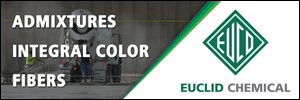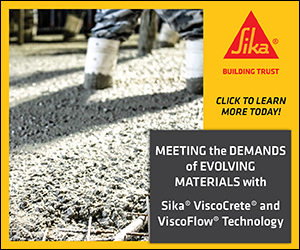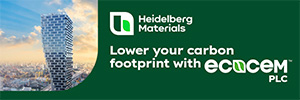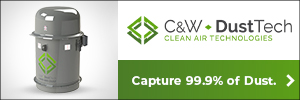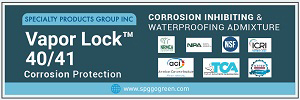 |
||||||||||||||
|
||||||||||||||
|
Association & Industry News
The estimated ready mixed concrete produced in August is 36.5 million cubic yards, 8.9% lower than in August 2023. The estimated production in the U.S. through July is 252 million cubic yards, approximately 5.8% lower than that during the same period in 2023. Ready mixed concrete production is estimated from cement shipments reported by the U.S. Geological Survey. More detail is available here.
Engineering
The American Concrete Institute's Fall Convention was held from November 2 - 6 in Philadelphia; the following summaries of committee activity involved NRMCA Engineering Staff representation.
122 – Energy Efficiency of Concrete and Masonry Systems – With the publishing of ACI 122.2 and 122.3 Thermal Properties of Concrete and Masonry for Residential and Commercial Buildings, the ACI 122R-14 Guide will be transitioned to a historical document. The committee also hosted a full session at the convention titled, Chill Out! Reduce Operational Energy and Carbon with Thermal Mass, featuring presentations on Threats to Mass Walls in the Energy Codes, The Benefits of Using ACI 122.1 for Compliance with Thermal Bridging Requirements and Reducing Energy Use with Mass Walls. Darryl Dixon maintains representation in ACI 122. The Fall 2024 newsletter of the National Concrete Consortium is now available online and includes the following items:
• Understanding Environmental Product Declarations (EPDs): The Fall 2024 NC² Moving Advancements into Practice (MAP) Brief from the NC² Resource Library examines the use of Environmental Product Declarations (EPDs) by federal, state and local government agencies aiming to reduce embodied carbon emissions. An EPD is an independently-verified report that communicates the embodied environmental impacts associated with construction materials. Buildings
The next session of the Concrete Innovations series, titled Decarbonizing Cement, will be held Wednesday, November 20, from 11 a.m. to 1 p.m. Eastern time. This session will focus on cement decarbonization strategies with a look at carbon capture and storage opportunities, and innovative blended cements. Participants will also hear from two software tool providers on how one can use data to help measure and lower the carbon footprint of concrete using these innovative cements and other low-carbon concrete strategies. Presentations include:
Click here to register and visit www.concreteinnovations.com for session details. For more information, contact Lionel Lemay at llemay@nrmca.org or 847-922-7995.  NRMCA Senior Director, Building Innovations, Frank Mruk recently helped judge the 60th American Institute of Architects Long Island Design Awards. There were over 150 applicants for the 20 coveted ARCHI award trophies. They were presented by AIA Long Island President Kenneth R. Gehringer at an AIA Long Island black tie gala at the Garden City Hotel in Garden City, NY, on November 7. Over 500 architects and their families attended the event. The AIA LI ARCHI awards recognize design excellence in architecture and provide professional recognition for architects who contribute to a better quality of life through their creativity and imagination. The awards program also aims to increase public awareness of quality architecture in the built environment. The Build With Strength program is a leader in helping architects design safe, sustainable and resilient buildings. For more information, contact Frank Mruk at fmruk@nrmca.org.
NRMCA sent representation to the 2024 ASHRAE Interim Fall Meetings held October 15 - 18) in Atlanta. Darryl Dixon, director, energy codes and standards, participated in ASHRAE Project Committee meetings on energy standards for sites/buildings. Provisions for opaque envelope assemblies, thermal bridging in the clear field, energy credits, air leakage, wall reflectance and net zero operational carbon were among the specific topics addressed in the meetings, Dixon said. ASHRAE Project Committees (PCs) continually develop new standards and guidelines, and revise current ones so that they reflect technical advances in the areas they cover. NRMCA tries to ensure that energy efficient and sustainable concrete solutions receive consideration in these industry standards. Click here for more information about NRMCA’s codes and standards advocacy efforts. Darryl Dixon can be reached at ddixon@nrmca.org. The 2024 National Council of Structural Engineers Associations (NCSEA) Summit took place in Las Vegas, NV, from November 5 - 8. Brandon Wray, senior director of building innovations, and Dr. Julian Mills-Beale, director of codes and standards, promoted Build With Strength (BWS) resources related to resilience and sustainability at the summit’s exhibition. The duo also networked with diverse stakeholders in the construction industry while participating in the Sustainable Design and Resilience Committee meetings to advocate for design and construction with concrete among the structural engineering community. Wray and Mills-Beale also had conversations focusing on leveraging BWS resources to improve concrete specifications while promoting the overall benefits of sustainable and resilient concrete design. For more information about NRMCA’s engagement with NCSEA, contact Dr. Julian Mills-Beale at jmills-beale@nrmca.org or Brandon Wray, bwray@nrmca.org. Pavement
The Concrete Council of St. Louis recently held a demonstration of a municipal slab replacement (seen here) in the City of Manchester, MO, incorporating several new concrete technologies, reports NRMCA Senior Director, Local Paving, Luke McHugh. A section of First Street in Manchester was repaved and the concrete mix included liquid fly ash and internal cure admixtures. These materials provide a number of benefits to the owner as well as to the contractor placing the concrete, McHugh said, noting that similar materials are available from most major admixture producers. Sensors were also placed prior to the pour that would transmit concrete strength in real time to a data logger via cellphone. Early results indicate 7-day strength of 4,400 psi+ and comparisons to cylinder breaks will be made at 28 days. Plans are also being made to test placement of sensors in structural and floor slab projects. Jesse Jonas, PE, is leading the Concrete Council efforts to bring these and other new technologies to the industry in Missouri and Illinois. For more information, contact Skip Dulle, executive director, Concrete Council of St. Louis at oad@concretecouncil.com or Luke McHugh at lmchugh@nrmca.org. Calendar
November 20 - 22, Oklahoma City 2025 February 3 - 7, Dallas March 4 - 7, Tucson, AZ October 10 - 14, Orlando, FL |
||||||||||||||




